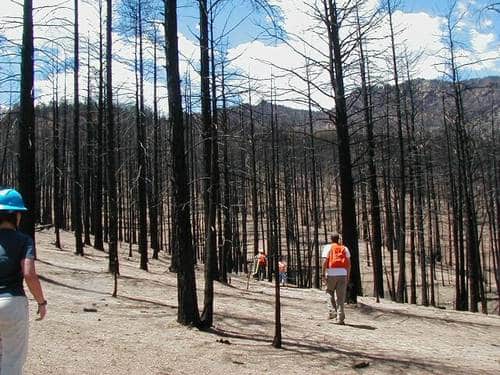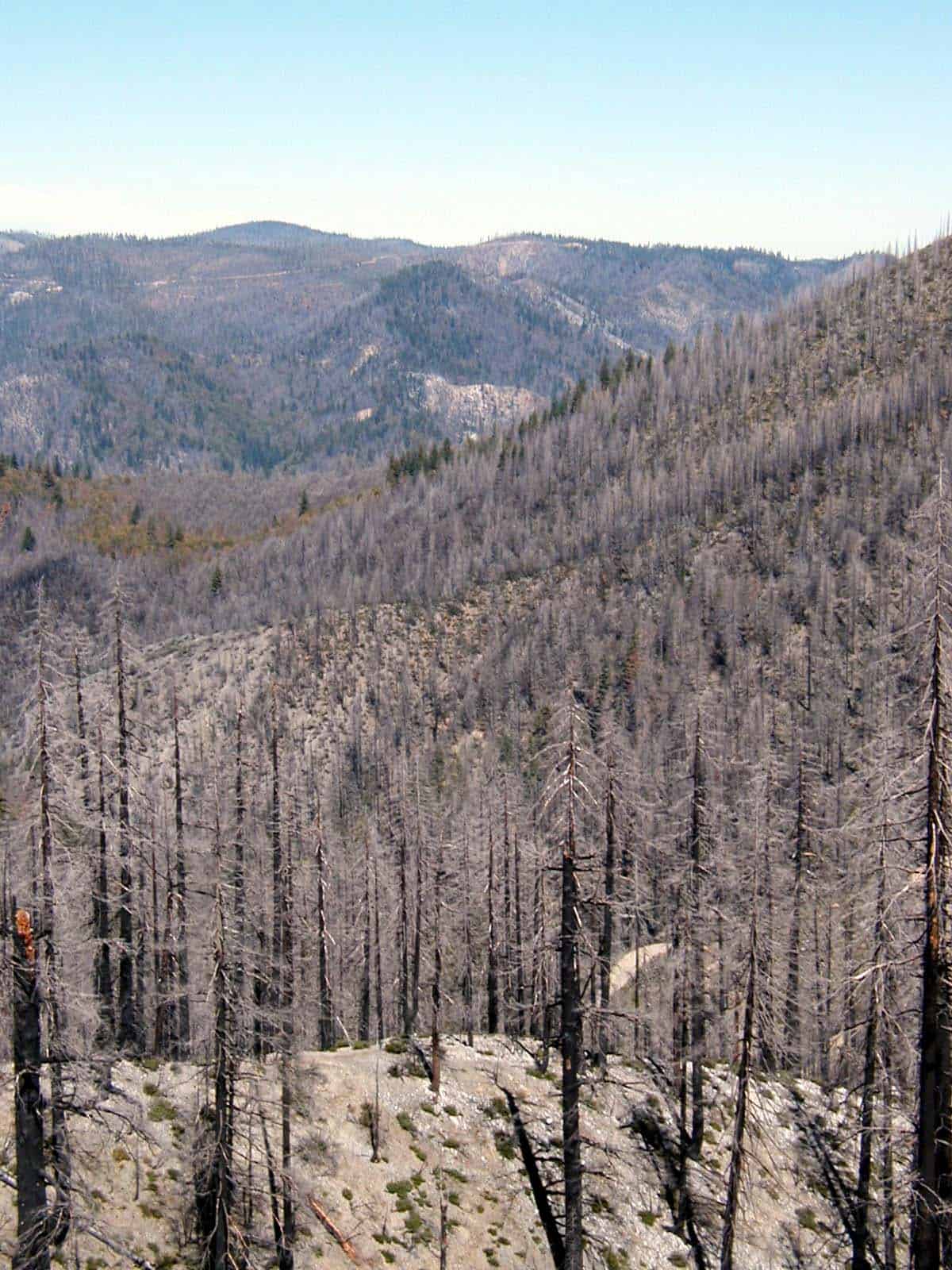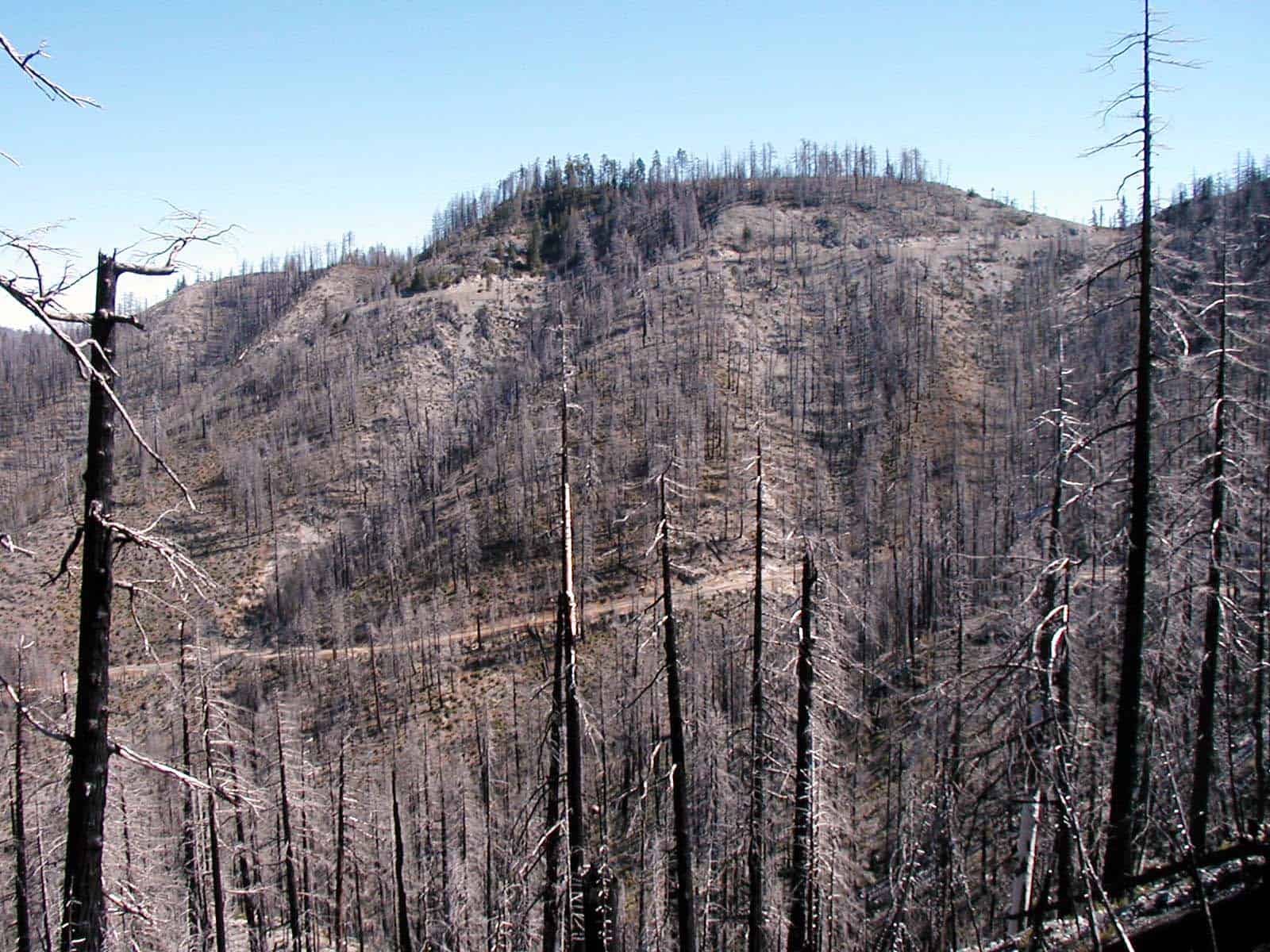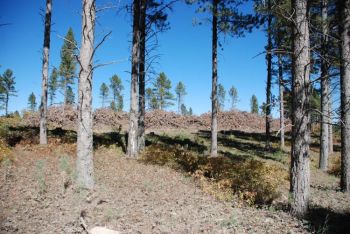photo by Matthew Koehler

Giving Thanks for Burned Forests
By Matthew Koehler
The first time I walked through this piece of the Lolo National Forest, smoke was still rising from the deep duff layer of the old-growth spruce-fir forest. It was a crisp, blue-bird October day seven years ago and I was leading a team of University of Montana students on a monitoring trip to get a first-hand lesson in fire ecology.
It was the height the Bush Administration’s effort to pass the so-called Healthy Forest Initiative and roll-back many of our nation’s landmark environmental laws, all of which seems like a long-forgotten bad dream.
The original intent of our monitoring trip on that October day in 2003 was to document fire behavior in the heavily logged and roaded lands of Plum Creek Timber Company compared to adjacent unlogged wildlands on the Lolo National Forest.
That distinction became quite clear as our team biked six miles – and 2,500 vertical feet – up the watershed and were afforded ever-expanding views of the cut-over Plum Creek land. It was quickly evident why crews fighting this fire dubbed the Plum Creek lands “the black desert.” For miles and miles all the eye could see were cut-over lands burnt to a crisp and a network of newly exposed logging roads.
The stark scene before us certainly didn’t conjure up the image of “leaders in environmental forestry,” which the timber company’s sign at the bottom of the watershed proudly proclaimed.
Exhausted, yet relieved to be beyond the reach of industrial forest management, we arrived at a remote trailhead and began walking down a trial that passed through a beautiful unlogged forest and eventually an officially designated Wilderness area. Our noses were overcome with the unique aroma of the recently burnt forest as we took in the mosaic patterns of wildfire across the landscape. A few trees torched over hereŠa light ground fire thereŠa hillside with jet-black snags from a high intensity fire directly adjacent to a ravine that was completely untouched.
These are the mysterious – even enchanting – patterns of low, moderate and high-intensity fires I have come to know and appreciate during my many subsequent trips to recently burned and recovering post-fire landscapes throughout the northern Rockies.
While it seems like some people want us to think that all modern wildfires are bad those of us who actually get out on the ground know a simple truth: our forests and wildlife evolved with fire, including “catastrophic” fire, and burnt forests are not the lifeless, unhealthy landscapes that some would like us to believe.
A few summer’s ago Dr. Richard Hutto, director of the Avian Science Center at the University of Montana, put it quite nicely when he wrote, “It’s important for the public and policymakers to recognize the important role that severely burned forests play in maintaining wildlife populations and healthy forests. Severely burned forests are neither ‘destroyed’ nor ‘lifeless.’ From my perspective as an ecologist, I have become aware of one of nature’s best-kept secrets -there are some plant and animal species that one is hard-pressed to see anywhere outside a severely burned forest.”
Indeed, at least 60 species of birds and mammals use burned forests because they provide the ideal habitat. While the logging industry might call burned forests “destroyed,” many critters call these same forests home.
So, imagine my surprise, when a few months after our monitoring trip, I received notice of the Lolo’s first “Healthy Forest” logging project. You guessed it! The plan was to cut down that same old-growth forest, which burned in such a beautiful mosaic. Apparently out of all the areas on the Lolo National Forest, logging along a popular hiking trail directly adjacent to a designed Wilderness Area was, quite literally, the top priority.
At the time, Mark Rey ¬- the former logging lobbyist who has run the Forest Service for the Bush Administration – scoffed at the notion that anyone would dare question his post-fire logging plans. In a quote I will never forget, Rey referred to these recently burned forests as “moonscapes,” telling a local paper that if we forest activists were successful “those moonscapes will stand as a monument to that idiocy.”
Well, we forest activists were successful. Our success came not from an official appeal or a lawsuit, but from good old fashioned public pressure. Once the spring snows cleared, we organized a field trip to the proposed logging site with Lolo National Forest officials and invited the public and the local media. You got the sense that as our caravan finally came to rest far up in the mountains – fifteen miles from the nearest home – that the forest supervisor knew this wasn’t an appropriate place for one of the first “healthy forest” logging projects. A few weeks later the supervisor called and told me she was canceling the timber sale.
Now-a-days, when I come back to this corner of the Lolo National Forest it’s with a rifle slung across my shoulder. Briskly walking up the same hiking trail in the cool, pre-dawn darkness – my headlight catching the steam from my quickening breath – I’m searching for elk, one of the many creatures who rely on recovering post-fire landscapes for food, shelter and security.
Seven years have passed since the wildfire burned across this landscape and as the sun slowly rises signs of a healthy, recovering ecosystem are everywhere: fir and lodgepole seedlings almost hip high; lightly charred bark of massive, fire-resident larch; the prehistoric call of the pileated woodpecker; the eerie bugle of a bull elk just over the ridge.
These are the healthy, recovering burnt forests that the logging industry lobbyists don’t want you to know about, because contained in these forests is a truth that belies their “moonscape” rhetoric.
As a childhood friend from Wisconsin and I finish quartering a cow elk, which was grazing on grasses and forbs rejuvenated by the wildfire, he turns to me and says, “These forests are pretty spectacular. They’re nothing like I would have expected listening to way some people talk so negatively about wildfire. Thanks for sharing this amazing experience with me.”
Our legs nearly buckle as we load close to 300 pounds of elk on our backs and struggle through the backcountry and eventually to the hiking trail through the old-growth spruce-fir forest, still standing as silent, yet powerful, monuments to a higher truth and the healing powers of nature.
This holiday season, as we gather with friends and family to enjoy the bountiful harvest from our garden and local farmers and count our many blessings, the menu will again include elk and morel mushroom stuffing. And once again as we go around the circle and say what we are thankful for, I’ll find myself giving thanks for wildfire and the wonders of our beautiful, burned forests.












